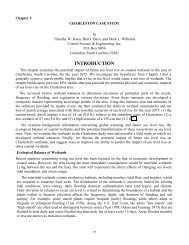Spherical Mechanism Synthesis in Virtual Reality - Florida Institute ...
Spherical Mechanism Synthesis in Virtual Reality - Florida Institute ...
Spherical Mechanism Synthesis in Virtual Reality - Florida Institute ...
Create successful ePaper yourself
Turn your PDF publications into a flip-book with our unique Google optimized e-Paper software.
positions have been placed, the spherical constra<strong>in</strong>t surface is<br />
def<strong>in</strong>ed and displayed. The rema<strong>in</strong><strong>in</strong>g two positions are<br />
conf<strong>in</strong>ed to the sphere def<strong>in</strong>ed by the first two position choices.<br />
After four positions are placed, the user selects the desired<br />
order <strong>in</strong> which the mechanism should move through them. At<br />
this po<strong>in</strong>t, the fixed and mov<strong>in</strong>g axis cones or the type map may<br />
be generated. Isis gives the position <strong>in</strong>formation to the Sph<strong>in</strong>x<br />
computation rout<strong>in</strong>es, and the Sph<strong>in</strong>x algorithms return the<br />
appropriate <strong>in</strong>formation.<br />
The ability to work with geometric models is a feature that<br />
sets Isis apart from previous approaches to design. Motion<br />
synthesis with<strong>in</strong> the context of its application allows users to see<br />
right away whether or not a mechanism is feasible for its<br />
<strong>in</strong>tended use. Unwanted collisions between objects can<br />
<strong>in</strong>stantly be seen, and the design can be altered immediately.<br />
Figure 3 depicts four <strong>in</strong>stances of a tray model placed around a<br />
chair that will act as a base for a mechanism. It can clearly be<br />
seen that the <strong>in</strong>tended task of the mechanism <strong>in</strong> this example<br />
will be to move the tray from its work<strong>in</strong>g position to its stowed<br />
location. This would not be evident if a user were to work<br />
exclusively with coord<strong>in</strong>ate frames, as can be seen <strong>in</strong> Figure 4,<br />
which shows the same four positions <strong>in</strong> Sph<strong>in</strong>x. The design<br />
emphasis <strong>in</strong> Isis is placed on def<strong>in</strong><strong>in</strong>g the task of mov<strong>in</strong>g the<br />
tray table, as opposed to plac<strong>in</strong>g coord<strong>in</strong>ate frames on a<br />
constra<strong>in</strong>t sphere.<br />
Figure 4 - Tray Positions <strong>in</strong> Sph<strong>in</strong>x<br />
Figure 5 shows another example of a spherical motion<br />
synthesis task that benefits from us<strong>in</strong>g geometric models. A<br />
designer can create a mechanism that ensures that the soda can<br />
will travel along a path that is free of obstruction.<br />
Figure 5 - Soda Can Task<br />
Cones<br />
Sph<strong>in</strong>x rout<strong>in</strong>es calculate the fixed and mov<strong>in</strong>g axis cones,<br />
and Isis displays these as red and blue 3-D curves. Users of Isis<br />
are able to see l<strong>in</strong>ks appear as selections are made on the cones.<br />
When two l<strong>in</strong>ks are chosen, a coupler curve appears, and a<br />
message box opens to tell the user what type of l<strong>in</strong>kage has<br />
been synthesized. The user may then move the axes to see how<br />
the l<strong>in</strong>kage and coupler curve change. Figure 6 shows a user<br />
creat<strong>in</strong>g a l<strong>in</strong>k by pick<strong>in</strong>g on the red fixed axis cone.<br />
Figure 6 - Pick<strong>in</strong>g Cones<br />
4 Copyright © 1998 by ASME
















